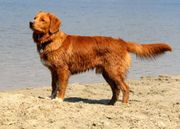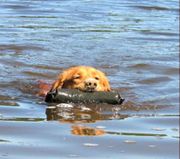Nova Scotia Duck-Tolling Retriever
 |
|||||||||||||||||||||||||
| Tolling Retriever | |||||||||||||||||||||||||
| Other names | Yarmouth Toller Tolling Retriever Little Red Duck Dog Little River Duck Dog |
||||||||||||||||||||||||
|---|---|---|---|---|---|---|---|---|---|---|---|---|---|---|---|---|---|---|---|---|---|---|---|---|---|
| Nicknames | Toller, Scotty, Novie | ||||||||||||||||||||||||
| Country of origin | Canada (Nova Scotia) | ||||||||||||||||||||||||
|
|||||||||||||||||||||||||
|
|||||||||||||||||||||||||
| Dog (Canis lupus familiaris) | |||||||||||||||||||||||||
The Nova Scotia Duck Tolling Retriever, or Toller for short, is one of the most unusual breeds of gundog in how the dog works. The hunter stays hidden in a blind and sends the dog out to romp and play near the water, usually by tossing a ball or stick to be retrieved. Just like the fox, the dog's activity and white markings pique the curiosity of waterfowl, who swim over to investigate. The act of enticing or luring game to approach is known as "tolling". When the birds are close, the hunter calls the dog back to the blind, then rises, putting the birds to flight, allowing him a shot. The Toller then retrieves any downed birds.
Contents |
History
The breed was developed in the community of Little River Harbour in Yarmouth County, Nova Scotia around the beginning of the 20th Century to toll waterfowl.[1] Its exact origins are not known but it appears that some Cocker Spaniel, Golden Retriever, or Irish Setter may have gone into the mix. It may share origins with the smaller Kooikerhondje, which has a similar method of work.
The Toller was officially admitted to the Canadian Kennel Club in 1945. 56 years later on June 11, 2001 it was approved for admission into the Miscellaneous Class of the American Kennel Club and was granted full recognition into the Sporting Group on July 1, 2003.
The Toller was made the provincial dog of Nova Scotia in 1995. [2]
Description
Appearance
According to the breed standards, the Toller should be athletic, well-muscled, compact, medium boned, balanced and powerful. The chest is deep. Conformation judges require Tollers to be capable of tolling, and physical faults that inhibit working ability are heavily penalized. They should be of moderate build—a lack of substance or a heavy build are penalized by judges, as both detract from the type and athleticism. The legs are sturdy and solid.
Those who breed Tollers for conformation shows consider the head (clean cut, slightly wedge-shaped) to be an important feature, and believe it should resemble that of a fox and must never be blocky like that of a Golden Retriever. The ears are triangular and set high and well back from the skull.
The tail is well-feathered and held jauntily when the dog is excited or moving.
Coat and color

Color is any shade of red, ranging from a golden red through dark coppery red, with lighter featherings on the underside of the tail, pantaloons, and body. Even the lighter shades of golden red are deeply pigmented and rich in color. The Toller should not be buff or brown. Although very rare, there are chocolate/liver brown Duck Tollers.
The Toller has usually at least one of the following white markings - tip of tail, feet (not extending above the pasterns) chest and blaze. Lack of white is not a fault.
"The Toller was bred to retrieve from icy waters and must have a water-repellent double coat of medium length and softness, and a soft dense undercoat. The coat may have a slight wave on the back, but is otherwise straight. Some winter coats may form a long loose curl at the throat. Featherings are soft and moderate in length. The hair on the muzzle is short and fine. Seasonal shedding is to be expected."[3] Over-coated specimens are not appropriate for a working dog.
Size and proportions
Tollers are the smallest of all the retriever breeds. They range in height from 17 to 21 inches at the withers,[1] and weigh 37 to 51 pounds (17-23 kg);[4] females are slightly shorter and lighter. Tollers are always a medium-sized breed, never large; however, there has been a trend towards larger dogs in recent years.
Tollers should be slightly longer than tall (a ratio of approximately 10 to 9). However, they should not appear long-backed.
Temperament
"The Toller is highly intelligent, alert, outgoing, loving, and ready for action, though not to the point of nervousness or hyperactivity. It is affectionate with family members and is good with children, showing great patience. Some individuals may display reserved behavior in new situations, but this is not to be confused with shyness... The Toller's strong retrieving desire coupled with his love of water, endurance and intense birdiness, is essential for its role as a tolling retriever. "[3]

Health
Tollers are generally hearty. However, they, like almost all dog breeds, have certain genetic disorders that are prevalent in the breed. This is sometimes blamed on a relatively small gene pool, a problem that is aggravated because some people buying Tollers only want dogs that are bred in Nova Scotia, believing that Nova Scotian dogs are the only "true" Tollers. The Toller's hereditary diseases include:
- Addison's Disease
- Progressive retinal atrophy
- Hip dysplasia
The average life span is about 12-14 years.
External links
- The Nova Scotia Duck Tolling Retriever Group
- Nova Scotia Duck Tolling Retriever Club (USA)
- Nova Scotia Duck Tolling Retriever Club of Canada
- Nova Scotia Duck Tolling Retriever Club (UK)
- The Toller Club Of Great Britain - Breed Club For The Nova Scotia Duck Tolling Retriever
- tollernet.de
- Nova Scotia Duck-Tolling Retriever Club of Poland
Gallery
 4 month old Toller puppy retrieving from water |
Tollers love the water |
 Male Toller at 8 weeks old |
(Left to Right) Size comparison of a juvenile male Toller and the adult sire |
Juvenile male Toller at 1 year |
|
Toller swimming |
(Left to Right) Female & male Tollers in the water |
References
- ↑ 1.0 1.1 http://www.ckc.ca/en/Default.aspx?tabid=99&BreedCode=RNS The Canadian Kennel Club: Nova Scotia Duck Tolling Retriever Breed Standard. Retrieved May 25, 2007
- ↑ http://www.gov.ns.ca/legislature/HOUSE_OF_ASSEMBLY/Symbols/dog.htm Nova Scotia House of Assembly: The Nova Scotia Duck Tolling Retriever. Retrieved May 25, 2007.
- ↑ 3.0 3.1 http://www.akc.org/breeds/nova_scotia_duck_tolling_retriever/index.cfm The American Kennel Club: Nova Scotia Duck Tolling Retriever Breed Standard. Retrieved May 31, 2008
- ↑ http://www.ankc.aust.com/novascot.html Australian National Kennel Council: Nova Scotia Duck Tolling Retriever Breed Standard. Retrieved May 25, 2007
|
||||||||||
|
|||||||||||||||||